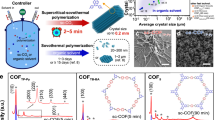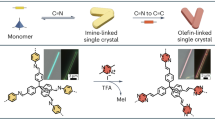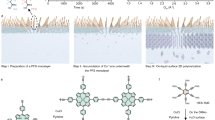Abstract
Two-dimensional polymers (2DPs) and their layer-stacked 2D covalent organic frameworks (2D COFs) are classes of structurally defined crystalline polymeric materials with exotic physical and chemical properties. Yet, synthesizing 2DP and 2D COF single crystals via irreversible reactions remains challenging. Here we report the synthesis of charged 2DP (C2DP) single crystals through an irreversible Katritzky reaction, under pH control, on a water surface. The periodically ordered 2DPs comprise aromatic pyridinium cations and counter BF4− anions. The C2DP crystals, which are composed of linked porphyrin and pyrylium monomers (C2DP-Por), have a tunable thickness of 2–30 nm and a lateral domain size up to 120 μm2. Single crystals with a square lattice (a = b = 30.5 Å) are resolved by imaging and diffraction methods with near-atomic precision. Furthermore, the integration of C2DP-Por crystals in an osmotic power generator device shows an excellent chloride ion selectivity with a coefficient value reaching ~0.9 and an output power density of 4 W m−2, superior to those of graphene and boron nitride.

This is a preview of subscription content, access via your institution
Access options
Subscribe to this journal
Receive 12 digital issues and online access to articles
$119.00 per year
only $9.92 per issue
Buy this article
- Purchase on SpringerLink
- Instant access to full article PDF
Prices may be subject to local taxes which are calculated during checkout





Similar content being viewed by others
Data availability
The data supporting the findings of this study are available within the article and its Supplementary Information. The X-ray crystallographic coordinates for the structure reported in this article have been deposited at the Cambridge Crystallographic Data Centre (CCDC), under CCDC deposition no. 2000610. These data can be obtained free of charge from the CCDC via http://www.ccdc.cam.ac.uk/data_request/cif. Experimental procedures and characterization of the new compounds are available in the Supplementary Information. Source data are provided with this paper.
Change history
23 February 2023
A Correction to this paper has been published: https://doi.org/10.1038/s44160-023-00266-x
References
Feng, X. & Schlüter, A. D. Towards macroscopic crystalline 2D polymers. Angew. Chem. Int. Ed. 57, 13748–13763 (2018).
Côté, A. P. et al. Porous, crystalline, covalent organic frameworks. Science 310, 1166–1170 (2005).
Wang, H. et al. Recent progress in covalent organic framework thin films: fabrications, applications and perspectives. Chem. Soc. Rev. 48, 488–516 (2019).
Colson, J. W. et al. Oriented 2D covalent organic framework thin films on single-layer graphene. Science 332, 228–231 (2011).
Martínez-Abadía, M. et al. A wavy two-dimensional covalent organic framework from core-twisted polycyclic aromatic hydrocarbons. J. Am. Chem. Soc. 141, 14403–14410 (2019).
Xu, H., Gao, J. & Jiang, D. Stable, crystalline, porous, covalent organic frameworks as a platform for chiral organocatalysts. Nat. Chem. 7, 905–912 (2015).
Seo, J.-M., Noh, H.-J., Jeong, H. Y. & Baek, J.-B. Converting unstable imine-linked network into stable aromatic benzoxazole-linked one via post-oxidative cyclization. J. Am. Chem. Soc. 141, 11786–11790 (2019).
Liu, K. et al. On-water surface synthesis of crystalline, few-layer two-dimensional polymers assisted by surfactant monolayers. Nat. Chem. 11, 994–1000 (2019).
Wojtecki, R. J., Meador, M. A. & Rowan, S. J. Using the dynamic bond to access macroscopically responsive structurally dynamic polymers. Nat. Mater. 10, 14–27 (2011).
Ma, T. et al. Single-crystal x-ray diffraction structures of covalent organic frameworks. Science 361, 48–52 (2018).
Kory, M. J. et al. Gram-scale synthesis of two-dimensional polymer crystals and their structure analysis by X-ray diffraction. Nat. Chem. 6, 779–784 (2014).
Jin, E. et al. Two-dimensional sp2 carbon-conjugated covalent organic frameworks. Science 357, 673–676 (2017).
Zhuang, X. et al. A two-dimensional conjugated polymer framework with fully sp2-bonded carbon skeleton. Polym. Chem. 7, 4176–4181 (2016).
Lyu, H., Diercks, C. S., Zhu, C. & Yaghi, O. M. Porous crystalline olefin-linked covalent organic frameworks. J. Am. Chem. Soc. 141, 6848–6852 (2019).
Jadhav, T. et al. 2D poly(arylene vinylene) covalent organic frameworks via aldol condensation of trimethyltriazine. Angew. Chem. Int. Ed. 58, 13753–13757 (2019).
Pastoetter, D. L. et al. Synthesis of vinylene-linked two-dimensional conjugated polymers via the Horner–Wadsworth–Emmons reaction. Angew. Chem. Int. Ed. 59, 23620 (2020).
Liu, W. et al. A two-dimensional conjugated aromatic polymer via C–C coupling reaction. Nat. Chem. 9, 563–570 (2017).
Galeotti, G. et al. Synthesis of mesoscale ordered two-dimensional π-conjugated polymers with semiconducting properties. Nat. Mater. 19, 874–880 (2020).
Grill, L. et al. Nano-architectures by covalent assembly of molecular building blocks. Nat. Nanotechnol. 2, 687–691 (2007).
Clair, S. & de Oteyza, D. G. Controlling a chemical coupling reaction on a surface: tools and strategies for on-surface synthesis. Chem. Rev. 119, 4717–4776 (2019).
Grossmann, L. et al. On-surface photopolymerization of two-dimensional polymers ordered on the mesoscale. Nat. Chem. 13, 730–736 (2021).
Zhu, X. et al. A charge-density-tunable three/two-dimensional polymer/graphene oxide heterogeneous nanoporous membrane for ion transport. ACS Nano 11, 10816–10824 (2017).
Chen, C. et al. Bio-inspired nanocomposite membranes for osmotic energy harvesting. Joule 4, 247–261 (2020).
Harris, F. W., Chuang, K. C., Huang, S. A. X., Janimak, J. J. & Cheng, S. Z. D. Aromatic poly(pyridinium salt)s: synthesis and structure of organo-soluble, rigid-rod poly(pyridinium tetrafluoroborate)s. Polymer 35, 4940–4948 (1994).
Katritzky, A. R., Manzo, R. H., Lloyd, J. M. & Patel, R. C. Mechanism of the pyrylium/pyridinium ring interconversion. mild preparative conditions for conversion of amines into pyridinium ions. Angew. Chem. Int. Ed. 19, 306–306 (1980).
Katritzky, A. R. & Leahy, D. E. Kinetics and mechanism of the pyrylium to pyridinium cation transformation in dichloromethane. J. Chem. Soc. Perkin Trans. 2 1985, 171–174 (1985).
Yan, X., Augusti, R., Li, X. & Cooks, R. G. Chemical reactivity assessment using reactive paper spray ionization mass spectrometry: the Katritzky reaction. ChemPlusChem 78, 1142–1148 (2013).
Cheng, C., Jiang, G., Simon, G. P., Liu, J. Z. & Li, D. Low-voltage electrostatic modulation of ion diffusion through layered graphene-based nanoporous membranes. Nat. Nanotechnol. 13, 685–690 (2018).
Logan, B. E. & Elimelech, M. Membrane-based processes for sustainable power generation using water. Nature 488, 313–319 (2012).
Siria, A., Bocquet, M.-L. & Bocquet, L. New avenues for the large-scale harvesting of blue energy. Nat. Rev. Chem. 1, 0091 (2017).
Zhang, Z., Wen, L. & Jiang, L. Nanofluidics for osmotic energy conversion. Nat. Rev. Mater. 6, 622–639 (2021).
Feng, J. et al. Single-layer MoS2 nanopores as nanopower generators. Nature 536, 197–200 (2016).
Esfandiar, A. et al. Size effect in ion transport through angstrom-scale slits. Science 358, 511–513 (2017).
Ji, J. et al. Osmotic power generation with positively and negatively charged 2D nanofluidic membrane pairs. Adv. Funct. Mater. 27, 1603623 (2017).
Zhang, Z. et al. Oxidation promoted osmotic energy conversion in black phosphorus membranes. Proc. Natl Acad. Sci. USA 117, 13959–13966 (2020).
Kühne, T. D. et al. CP2K: an electronic structure and molecular dynamics software package—Quickstep: efficient and accurate electronic structure calculations. J. Chem. Phys. 152, 194103 (2020).
Perdew, J. P., Burke, K. & Ernzerhof, M. Generalized gradient approximation made simple. Phys. Rev. Lett. 77, 3865–3868 (1996).
Smith, D. G. A., Burns, L. A., Patkowski, K. & Sherrill, C. D. Revised damping parameters for the D3 dispersion correction to density functional theory. J. Phys. Chem. Lett. 7, 2197–2203 (2016).
Goedecker, S., Teter, M. & Hutter, J. Separable dual-space gaussian pseudopotentials. Phys. Rev. B 54, 1703–1710 (1996).
CrysAlis PRO (Agilent Technologies Ltd, 2014).
Dolomanov, O. V., Bourhis, L. J., Gildea, R. J., Howard, J. A. K. & Puschmann, H. OLEX2: a complete structure solution, refinement and analysis program. J. Appl. Cryst. 42, 339–341 (2009).
Sheldrick, G. A short history of SHELX. Acta Cryst. 64, 112–122 (2008).
Sheldrick, G. Crystal structure refinement with SHELXL. Acta Cryst. C 71, 3–8 (2015).
Acknowledgements
This work was financially supported by the EU Graphene Flagship (GrapheneCore3, no. 881603), an ERC starting grant (FC2DMOF, grant no. 852909), an ERC Consolidator Grant (T2DCP), a DFG project (2D polyanilines, no. 426572620), Coordination Networks: Building Blocks for Functional Systems (SPP 1928, COORNET), H2020-MSCA-ITN (ULTIMATE, no. 813036), H2020-FETOPEN (PROGENY, 899205), CRC 1415 (Chemistry of Synthetic Two-Dimensional Materials, no. 417590517), SPP 2244 (2DMP), CALIPSOplus under grant agreement 730872 from the EU Framework Programme for Research and Innovation HORIZON 2020, as well as the German Science Council and Center of Advancing Electronics Dresden. Z.W. gratefully acknowledges funding from the China Scholarship Council. The authors acknowledge the Center of Advancing Electronics Dresden, the Dresden Center for Nanoanalysis at TUD and P. Formanek and A. Fery for the use of the TEM facility at IPF, as well as M. Hambsch and S.C.B. Mannsfeld for GIWAXS measurements. We acknowledge Elettra Sincrotrone Trieste for providing access to its synchrotron radiation facilities, and we thank L. Barba and A. Johannes for assistance in using beamline XRD1 and beamline ID13, respectively.
Author information
Authors and Affiliations
Contributions
X.F. and R.D. conceived and designed the project. Z.W., M.W., L.W., K.X. and R.D. contributed to the synthesis of the 2D polymers and model compounds. Z.Z. and Z.W. contributed to the osmotic power generation measurements. H.Q., Z.W., R.D. and U.K. performed AC-HRTEM imaging and SAED, and the corresponding analysis. Z.W. and S.P. contributed to the GIWAXS measurement. Z.W., H.Q. and R.D. analysed the diffraction data and proposed the crystal structures. Z.W. performed the optical microscopy, AFM, TEM, ATR-FTIR and ultraviolet–visible measurements. A.O.-G., A.D., A.C. and G.C. contributed to the theory calculations and analysis. F.H. and J.J.W. performed the single-crystalline X-ray measurements and analysis. H.K. performed the NMR measurements on model compounds. Z.W., R.D. and X.F. co-wrote the manuscript, with contributions from all the authors.
Corresponding authors
Ethics declarations
Competing interests
The authors declare no competing interests.
Additional information
Peer review information Nature Synthesis thanks Nazario Martin, Arnold Rheingold and the other, anonymous, reviewer(s) for their contribution to the peer review of this work. Alison Stoddart was the primary editor on this article and managed its editorial process and peer review in collaboration with the rest of the editorial team.
Publisher’s note Springer Nature remains neutral with regard to jurisdictional claims in published maps and institutional affiliations.
Supplementary information
Supplementary Information
Supplementary Figs. 1–31, Discussion and Tables 1–3.
Supplementary Data 1
Cif file of compound 13.
Source data
Source Data Fig. 2
Statistical source data.
Source Data Fig. 4
Statistical source data.
Source Data Fig. 5
Statistical source data.
Rights and permissions
Springer Nature or its licensor (e.g. a society or other partner) holds exclusive rights to this article under a publishing agreement with the author(s) or other rightsholder(s); author self-archiving of the accepted manuscript version of this article is solely governed by the terms of such publishing agreement and applicable law.
About this article
Cite this article
Wang, Z., Zhang, Z., Qi, H. et al. On-water surface synthesis of charged two-dimensional polymer single crystals via the irreversible Katritzky reaction. Nat Synth 1, 69–76 (2022). https://doi.org/10.1038/s44160-021-00001-4
Received:
Accepted:
Published:
Issue date:
DOI: https://doi.org/10.1038/s44160-021-00001-4
This article is cited by
-
Investigation on the formation of two dimensional perovskite nanostructures at the water surface through self initiated reaction
Scientific Reports (2025)
-
Synthesis of micrometre-thick oriented 2D covalent organic framework films by a kinetic polymerization pathway
Nature Synthesis (2025)
-
Electronic and quantum properties of organic two-dimensional crystals
Nature Reviews Materials (2024)
-
Mimicking on-water surface synthesis through micellar interfaces
Nature Communications (2024)
-
Chaperone solvent-assisted assembly of polymers at the interface of two immiscible liquids
Nature Communications (2024)



